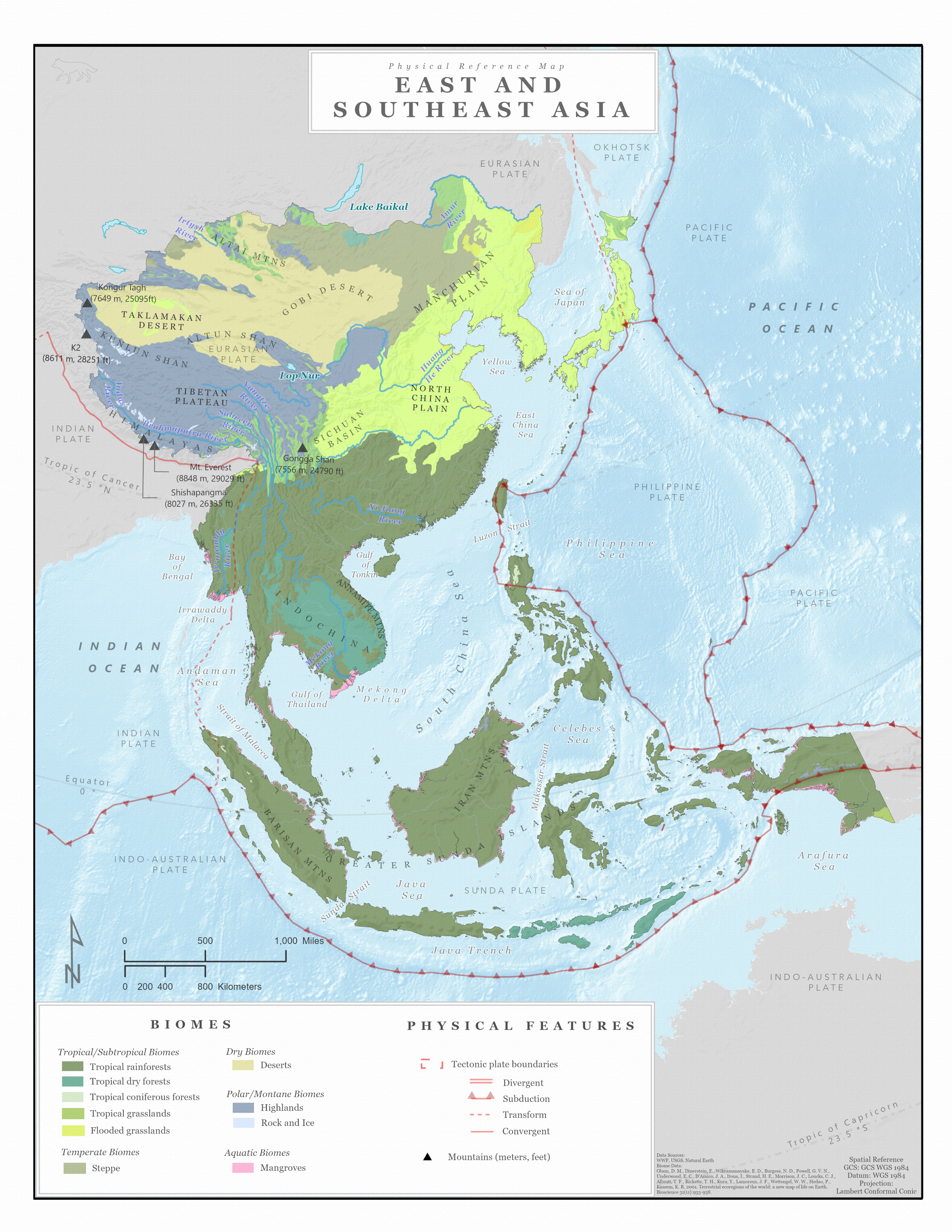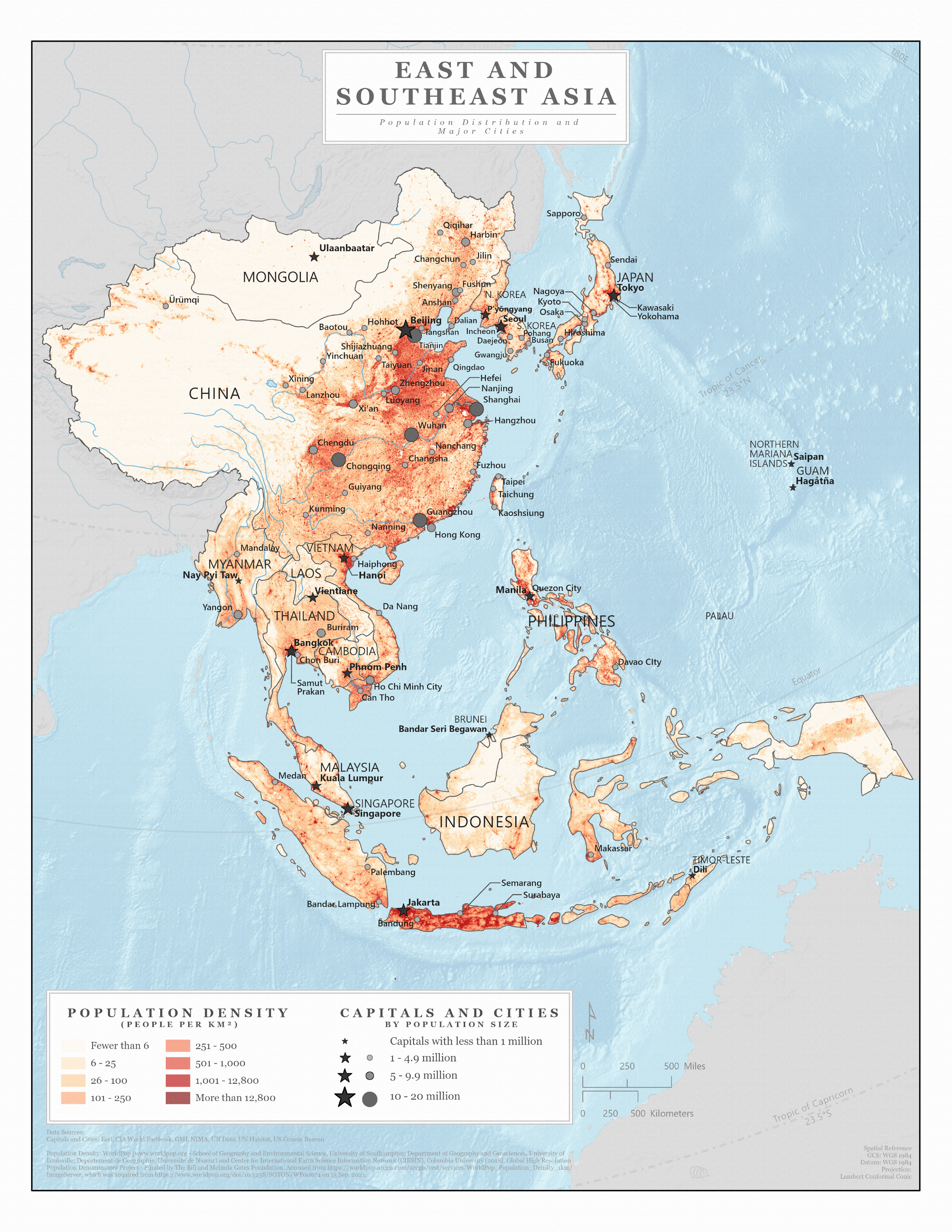8: East and Southeast Asia
- Page ID
- 147529
\( \newcommand{\vecs}[1]{\overset { \scriptstyle \rightharpoonup} {\mathbf{#1}} } \)
\( \newcommand{\vecd}[1]{\overset{-\!-\!\rightharpoonup}{\vphantom{a}\smash {#1}}} \)
\( \newcommand{\dsum}{\displaystyle\sum\limits} \)
\( \newcommand{\dint}{\displaystyle\int\limits} \)
\( \newcommand{\dlim}{\displaystyle\lim\limits} \)
\( \newcommand{\id}{\mathrm{id}}\) \( \newcommand{\Span}{\mathrm{span}}\)
( \newcommand{\kernel}{\mathrm{null}\,}\) \( \newcommand{\range}{\mathrm{range}\,}\)
\( \newcommand{\RealPart}{\mathrm{Re}}\) \( \newcommand{\ImaginaryPart}{\mathrm{Im}}\)
\( \newcommand{\Argument}{\mathrm{Arg}}\) \( \newcommand{\norm}[1]{\| #1 \|}\)
\( \newcommand{\inner}[2]{\langle #1, #2 \rangle}\)
\( \newcommand{\Span}{\mathrm{span}}\)
\( \newcommand{\id}{\mathrm{id}}\)
\( \newcommand{\Span}{\mathrm{span}}\)
\( \newcommand{\kernel}{\mathrm{null}\,}\)
\( \newcommand{\range}{\mathrm{range}\,}\)
\( \newcommand{\RealPart}{\mathrm{Re}}\)
\( \newcommand{\ImaginaryPart}{\mathrm{Im}}\)
\( \newcommand{\Argument}{\mathrm{Arg}}\)
\( \newcommand{\norm}[1]{\| #1 \|}\)
\( \newcommand{\inner}[2]{\langle #1, #2 \rangle}\)
\( \newcommand{\Span}{\mathrm{span}}\) \( \newcommand{\AA}{\unicode[.8,0]{x212B}}\)
\( \newcommand{\vectorA}[1]{\vec{#1}} % arrow\)
\( \newcommand{\vectorAt}[1]{\vec{\text{#1}}} % arrow\)
\( \newcommand{\vectorB}[1]{\overset { \scriptstyle \rightharpoonup} {\mathbf{#1}} } \)
\( \newcommand{\vectorC}[1]{\textbf{#1}} \)
\( \newcommand{\vectorD}[1]{\overrightarrow{#1}} \)
\( \newcommand{\vectorDt}[1]{\overrightarrow{\text{#1}}} \)
\( \newcommand{\vectE}[1]{\overset{-\!-\!\rightharpoonup}{\vphantom{a}\smash{\mathbf {#1}}}} \)
\( \newcommand{\vecs}[1]{\overset { \scriptstyle \rightharpoonup} {\mathbf{#1}} } \)
\( \newcommand{\vecd}[1]{\overset{-\!-\!\rightharpoonup}{\vphantom{a}\smash {#1}}} \)
\(\newcommand{\avec}{\mathbf a}\) \(\newcommand{\bvec}{\mathbf b}\) \(\newcommand{\cvec}{\mathbf c}\) \(\newcommand{\dvec}{\mathbf d}\) \(\newcommand{\dtil}{\widetilde{\mathbf d}}\) \(\newcommand{\evec}{\mathbf e}\) \(\newcommand{\fvec}{\mathbf f}\) \(\newcommand{\nvec}{\mathbf n}\) \(\newcommand{\pvec}{\mathbf p}\) \(\newcommand{\qvec}{\mathbf q}\) \(\newcommand{\svec}{\mathbf s}\) \(\newcommand{\tvec}{\mathbf t}\) \(\newcommand{\uvec}{\mathbf u}\) \(\newcommand{\vvec}{\mathbf v}\) \(\newcommand{\wvec}{\mathbf w}\) \(\newcommand{\xvec}{\mathbf x}\) \(\newcommand{\yvec}{\mathbf y}\) \(\newcommand{\zvec}{\mathbf z}\) \(\newcommand{\rvec}{\mathbf r}\) \(\newcommand{\mvec}{\mathbf m}\) \(\newcommand{\zerovec}{\mathbf 0}\) \(\newcommand{\onevec}{\mathbf 1}\) \(\newcommand{\real}{\mathbb R}\) \(\newcommand{\twovec}[2]{\left[\begin{array}{r}#1 \\ #2 \end{array}\right]}\) \(\newcommand{\ctwovec}[2]{\left[\begin{array}{c}#1 \\ #2 \end{array}\right]}\) \(\newcommand{\threevec}[3]{\left[\begin{array}{r}#1 \\ #2 \\ #3 \end{array}\right]}\) \(\newcommand{\cthreevec}[3]{\left[\begin{array}{c}#1 \\ #2 \\ #3 \end{array}\right]}\) \(\newcommand{\fourvec}[4]{\left[\begin{array}{r}#1 \\ #2 \\ #3 \\ #4 \end{array}\right]}\) \(\newcommand{\cfourvec}[4]{\left[\begin{array}{c}#1 \\ #2 \\ #3 \\ #4 \end{array}\right]}\) \(\newcommand{\fivevec}[5]{\left[\begin{array}{r}#1 \\ #2 \\ #3 \\ #4 \\ #5 \\ \end{array}\right]}\) \(\newcommand{\cfivevec}[5]{\left[\begin{array}{c}#1 \\ #2 \\ #3 \\ #4 \\ #5 \\ \end{array}\right]}\) \(\newcommand{\mattwo}[4]{\left[\begin{array}{rr}#1 \amp #2 \\ #3 \amp #4 \\ \end{array}\right]}\) \(\newcommand{\laspan}[1]{\text{Span}\{#1\}}\) \(\newcommand{\bcal}{\cal B}\) \(\newcommand{\ccal}{\cal C}\) \(\newcommand{\scal}{\cal S}\) \(\newcommand{\wcal}{\cal W}\) \(\newcommand{\ecal}{\cal E}\) \(\newcommand{\coords}[2]{\left\{#1\right\}_{#2}}\) \(\newcommand{\gray}[1]{\color{gray}{#1}}\) \(\newcommand{\lgray}[1]{\color{lightgray}{#1}}\) \(\newcommand{\rank}{\operatorname{rank}}\) \(\newcommand{\row}{\text{Row}}\) \(\newcommand{\col}{\text{Col}}\) \(\renewcommand{\row}{\text{Row}}\) \(\newcommand{\nul}{\text{Nul}}\) \(\newcommand{\var}{\text{Var}}\) \(\newcommand{\corr}{\text{corr}}\) \(\newcommand{\len}[1]{\left|#1\right|}\) \(\newcommand{\bbar}{\overline{\bvec}}\) \(\newcommand{\bhat}{\widehat{\bvec}}\) \(\newcommand{\bperp}{\bvec^\perp}\) \(\newcommand{\xhat}{\widehat{\xvec}}\) \(\newcommand{\vhat}{\widehat{\vvec}}\) \(\newcommand{\uhat}{\widehat{\uvec}}\) \(\newcommand{\what}{\widehat{\wvec}}\) \(\newcommand{\Sighat}{\widehat{\Sigma}}\) \(\newcommand{\lt}{<}\) \(\newcommand{\gt}{>}\) \(\newcommand{\amp}{&}\) \(\definecolor{fillinmathshade}{gray}{0.9}\)Re-framing East and Southeast Asia
In grouping East and Southeast Asia together as a collective for this chapter, the region will illustrate similarities that connect the region and highlight the importance in distinguishing the many defining attributes of both that makeup the vast region. China is the glaring superpower nation within the collective realm, serving as a somewhat nucleus for geopolitical, economic, and military strategic planning of east and southeast Asia. Part of China's rise out of the Maoist era in the late 1970s was the further development of conformists' communist rule that merge with western capitalism practices. With China's current leader Xi Jianping amassing an indefinite reign, the nation is seemingly poised to continuing become a major force of global influence that is aiming to replace western society's imprint upon the global stage. Past western stereotypes of the nation being stagnate and a somewhat recent past history of being oppressed by Japan, is not a distant memory as the nation continue to expand exponentially in various modes of development. China's continued growth and influence out of the 2020 pandemic has been contested by western theorists and intelligence communities as a somewhat facade, but its interests within neighboring Asia, Europe, Africa, and Central/South America continue to deepen. With China's expanding influence over the region, how will the stability of buffer zone and regional neighbors of the Korean Peninsula, Taiwan, Japan, and Mongolia be impacted? This is also with considerations to the smaller nations respective development, historical context, and ambitions. Mongolia is has a renown history tied to conquests with influences and roots stretching as far as Europe and extending farther over into the Americas. The tensions within the Korea Peninsula continue to be instigated by outside forces and China's exertion upon Taiwan to be "officially" annexed is growing with momentum. Also, will Japan be able to continue sustaining it's economy and a livelihood as a stand alone in the region with no formidable allies?
Is it fair to categorize southeast Asia as a mere subregion with no context as it relates to grander understandings of what is known as Asia? Definitely not! Many outer perceptions tend to view the region as a tourist's haven with some of the world's lowest cost of living standards for indulgence or exploitation. Tropical beaches, islands, coastlines, dense jungles, hills, seas, religious temples, street food markets, proximity to other inter-regional areas, fluid and flexible processes for visa requirements all aid the lure to the region. Although, the underbelly of southeast Asian urban lifestyle as it relates to industries, services, development, and illicit sectors are also key components of the region's identity. Despite the duality of perception versus the reality of regional livelihood that exists, the area has a rich history development that continues to strongly influence the region's stability. The people of southeast Asia continue to maintain cultural resilience as well, despite the different eras of conquests and natural occurrences that impact the area.
The collective of Asia continues to evolve, rapidly develop, and endure turmoil throughout various regions within Asia despite outer perceptions and societal assumptions. In current times, the ASEAN collective is potentially emerging as an economic force and center for natural resources refinement hyper-productivity. Migration trends throughout the region from outer-realm foreigners continues to fluctuate as interests in subregion is growing. A future of affluence sustained uneven development, environmental atrocities, catastrophic atmospheric occurrences, and modern appeal could be in the making of a distinguished complex ASEAN. Despite east Asia having a longstanding imprint of "modernity" compared to southeast Asia, high urban population density, ongoing development, modes of turmoil and prosperity may be within the grasp of East Asia's immediate future as the subregions aims to elevate regional livelihood. In this chapter, it is a primary goal for the authors to highlight and distinguish the region of Southeast Asia as its own evolving realm. Southeast Asia cannot be generalized under the "Asia" umbrella without appropriate context and comprehensive insight to the dynamics that continue to shape its landscape.
For each of the world regions, our original atlas provides detailed maps to help you navigate the places discussed in this book. These maps are meant to be explored before and during the reading of this chapter. These maps are best enjoyed enlarged. Click on each map for an enlarged view, and zoom in to see the prominent biomes, physical features, and population centers of East and Southeast Asia. We recommend that you download these for reference as you read this chapter's content and hope that you enjoy this original compilation.



